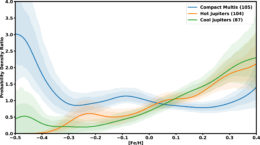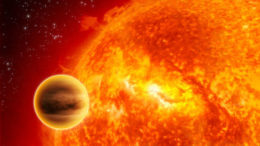Our search for worlds beyond our own solar system has revealed thousands of exoplanets in an incredible variety of sizes and configurations. But a new study has revealed that there may be a treasure trove of additional planets hiding where we can’t look as easily: close in around low-metallicity stars.
Exploring Architecture
In recent years, we’ve determined that the vast majority of stars in our galaxy host at least one planet. Generally, we observe two main types of exoplanetary system architectures close in around stars:
- hot jupiters, massive planets with very short orbital periods, and
- compact multi-planet systems, systems containing multiple small planets on tight orbits.
Led by John Brewer (Yale University and Columbia University), a team of scientists has now explored this odd trend more carefully by investigating how system architecture trends with the metallicities of host stars. Can we draw conclusions about what types of planets we expect to find in different systems?

Frequency of compact multi-planet systems (blue) increases with decreasing metallicity as a fraction of known planet hosts. Hot-Jupiter (orange) and cool-Jupiter (green) systems, on the other hand, become more frequent as metallicity increases. [Brewer et al. 2018]
An Unexpected Trend
Brewer and collaborators constructed a catalog of 716 stars known to host 1,148 planets. The team next obtained uniform high-resolution optical spectra for each of these stars with the Keck HIRES spectrograph, which they used to determine the abundances of heavy metals in the stars. They then compared the abundances for hosts of different system architectures.
Previous studies had already showed that hot Jupiters are preferentially found around higher metallicity stars, and the results from Brewer and collaborators’ sample confirmed this, showing a distinctive rise in the fraction of hosts that have both hot and cold Jupiters at higher metallicities.
More surprising, however, were the team’s results for compact multi-planet systems. While the frequency of these systems appears to remain roughly constant for stars around and above solar metallicities, the authors’ data show a large spike in frequency for compact multi-planet systems around stars of very low metallicities.
Surveys Past and Future

In the authors’ sample, stars with low metallicity or a high ratio of Si/Fe do not seem to form hot Jupiters, and they are increasingly likely to host compact multi-planet systems. [Brewer et al. 2018]
How have we missed this? To optimize for finding easy-to-detect hot Jupiters, past radial-velocity exoplanet surveys have primarily targeted high-metallicity hosts. But while current surveys lack the precision to detect the small planets of compact multi-planet systems, that will soon change with the introduction of new, extreme-recision radial-velocity instruments.
Brewer and collaborators’ results suggest that targeting low-metallicity stars with these upcoming surveys is the way to go — and there may be many more compact systems for us to find than we’d ever realized!
Another tantalizing detail is that these low-metallicity hosts tend to be older stars in our galaxy, suggesting that their planetary systems have had a long time to develop. This is good news for astrobiology enthusiasts: we may soon have a new reservoir of small planets to explore for life.
Citation
“Compact Multi-Planet Systems are more Common around Metal-Poor Hosts,” John M. Brewer et al 2018 ApJL 867 L3. doi:10.3847/2041-8213/aae710

